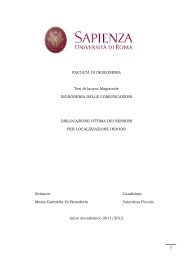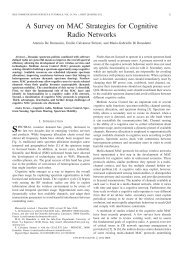AWGN Channel
AWGN Channel
AWGN Channel
- No tags were found...
You also want an ePaper? Increase the reach of your titles
YUMPU automatically turns print PDFs into web optimized ePapers that Google loves.
<strong>AWGN</strong> <strong>Channel</strong><strong>AWGN</strong> <strong>Channel</strong>NEuWb GroupDIET
<strong>AWGN</strong> <strong>Channel</strong>Outline<strong>Channel</strong> modelSimulation time!Results
<strong>AWGN</strong> <strong>Channel</strong><strong>Channel</strong> modelOutline<strong>Channel</strong> modelSimulation time!Results
<strong>AWGN</strong> <strong>Channel</strong><strong>Channel</strong> modelFramework (1/3)<strong>Channel</strong> model hypothesis◮ multipath-free◮ <strong>AWGN</strong> (and any other gaussian interference)◮ attenuation formula: α = c 0 / √ D γ , so α ≡ c 0 @ D = 1[m].Optimum receiver (for <strong>AWGN</strong> channels)◮ Correlator: it correlates r(t), the rx noisy signal (input), withthe orthonormal waveforms (ψ i ) N−1i=0of the signal space basis,giving a vector Z ∈ R N of decision variables (output).◮ Detector: it decides which wf was transmitted applying theML criterion, i.e. maximizing p(Z|s(t)).
<strong>AWGN</strong> <strong>Channel</strong><strong>Channel</strong> modelFramework (2/3)Two decision detection strategies may be used in case ofmulti-pulse signals:◮ SOFT: only one decision based on the whole multi-pulsesignal (SNR mp = N s SNR sp );◮ HARD: firstly N s independent decisions (with errorprobability p), then the final decision is obtained by applying amajority criterion, leading to:P e =∑N sk=N s/2( ) Nsp k (1 − p) Ns−k .k
<strong>AWGN</strong> <strong>Channel</strong><strong>Channel</strong> modelFramework (3/3)MOD_TXsTXTransmitterAttenuation1<strong>Channel</strong> Delay1zNoise1det_dataoutcorrML detectorZZcorrCorrelatorsRXn
<strong>AWGN</strong> <strong>Channel</strong>Simulation time!Outline<strong>Channel</strong> modelSimulation time!Results
<strong>AWGN</strong> <strong>Channel</strong>Simulation time!SchematicReceiversRXwnmasksmp_freqdataNsTsnBitsRXestBERMOD_RXProduct<strong>AWGN</strong> <strong>Channel</strong> SimulationMask generationrefsmp_freqNsdPPMmaskMOD_corr_maskMOD_TX(BPPM_TH, BPAM_DS)num_bitsNssmp_freqTcTsNpNhdPPMIR_dtaupowdBmdatacodesTXrefMOD_TX<strong>Channel</strong> attenuationsTXc0dgammasRXapathloss<strong>AWGN</strong>sRXwonSNRpnum_pulses_totsRXwnnoisegnoiseExN015gamma14d13c012avg_pow11wf_shape_factor10wf_time_duration9dither8code_max_val7code_length6frame_time5chip_time4smp_freq3num_pulses_per_bit2num_bits1
<strong>AWGN</strong> <strong>Channel</strong>Simulation time!Routines (1/2)We shall write three routines:◮ [sRX, a] = pathloss(sTX, c0, d, gamma)It implements the pathloss formula (as we’ve looked atpreviously).◮ [sRXwn, noise] = gnoise(sRXwon, SNRp, num pulses tot)It adds noise with suitable power to attain the desired SNRp:if N s > 1, then SNR p = E x /N 0 = E b /(N s N 0 ).◮ mask = corrmask(ref, smp freq, num pulses tot, dPPM)It generates the mask with which correlates the receivedsignal.
<strong>AWGN</strong> <strong>Channel</strong>Simulation time!Routines (2/2)◮ To implement the first block, you have to use the old routinefor the generation of PPM signals.◮ To implement the last block, you can use the already writtenroutine[det data,BER] = MOD receiver(...mod, rx, mask, smp freq, data, nBits, Ns, Ts)
<strong>AWGN</strong> <strong>Channel</strong>ResultsOutline<strong>Channel</strong> modelSimulation time!Results
<strong>AWGN</strong> <strong>Channel</strong>ResultsQuestionsYou should be able to answer to the following questions:1. What is the effect of N s on P e ?2. What are the performance difference btw soft and harddecisions?We invite you to highlight the hypotesis under which,according to you, this conclusion is true.
<strong>AWGN</strong> <strong>Channel</strong>ResultsThe main result10 0 SNR xN s=1N s=3, HARDN s=3, SOFT10 −1Pr e10 −210 −310 −40 1 2 3 4 5 6 7 8 9 10






